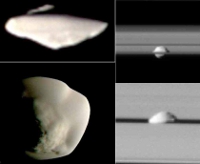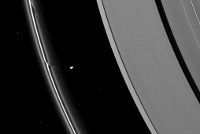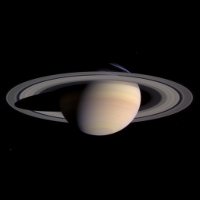Cassini Scientist for a day competition 2012: Target information
 |
To enter the competition students should study each of the three targets that Cassini will image and decide which one they think will yield the best science results.
A brief description of each of the targets is given below along with links to further information.
1. Pan - the shepherd moon
Pan, discovered in 1990, is Saturn's inner-most moon that orbits in a gap in one of the planets famous rings, known as the Encke gap. This moon is responsible for keeping this gap open and free of particles, hence it's nickname of the shepherd moon.
 |
|
Close-up views of Pan - the shepherd moon. Credit: NASA/JPL-Caltech/Space Science Institute |
It is a tiny world that is just 20 kilometres in diameter and has a rather unusual shape that somewhat resembles a walnut or a flying saucer due to its prominent equatorial ridge. Despite its small size Pan's gravitational field effects the rocky, icy material of the rings creating a wake either side of the gap as it passes by.
The Cassini spacecraft is studying Pan to try and find out more about what this moon is made out of, how its surface is shaped and its history.
To find out more about this target view the information on the 'Cassini Scientist for a Day' competition pages, go here
2. The F-ring
At first glance Saturn looks like it is surrounded by one giant ring, a closer inspection reveals that it is actually made up of a number of rings of different sizes and types of materials. The rings are names A to G, and the F-ring is Saturn's most dynamical ring.
The F-ring was discovered in 1979 by NASA's Pioneer 11 spacecraft. It is between 30 and 500 kilometres wide and the Cassini spacecraft has observed it to have one core ring with another strand spiralling around it.
 |
|
Saturn's F ring close-up. Credit: NASA/JPL - Caltech/Space Science Institute |
This is possibly the most active of Saturn's rings, with features seeming to change in a matter of hours. In early 2012, scientists studying observations by Cassini discovered small clumps of ice ploughing through the ring. These kilometre-sized ice balls leave sparkling trails behind. This along with many other processes taking place in Saturn's rings are not yet fully understood.
To find out more about this target view the information on the 'Cassini Scientist for a Day' competition pages, go here
3. Saturn
Saturn is the second largest planet in the Solar System and is mostly made up of hydrogen and helium. Known as a gas giant, this planet has no distinct boundary between its atmosphere and surface.
 |
|
Saturn in colour. Credit: NASA/JPL - Caltech/Space Science Institute |
Saturn is famous for its rings. There is a system of seven concentric rings surrounding the planet. The rings are composed from many icy and rocky particles ranging in size from that of a grain of sugar to a house, and each travelling in their own orbit. The rings of Saturn have baffled astronomers since they were discovered by Galileo Galilei in 1610.
The rings are constantly changing but what they are, their structure and how they formed is still under investigation.
To find out more about this target view the information on the 'Cassini Scientist for a Day' competition pages, go here
